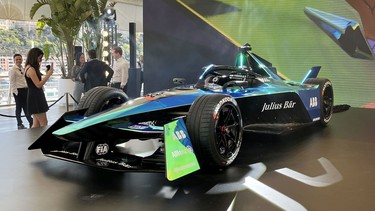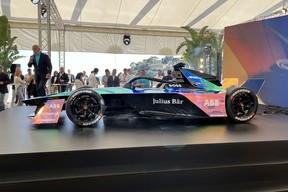Series CEO, Canadian Jamie Reigle, says Gen3 car will help Formula E “gain [its] mojo back” next season

Article content
Formula E has come a long way from the days when drivers had to swap between electric cars to have enough battery capacity to get through a race.
Advertisement 2
Article content
The series revealed its third-generation electric race car today atop the Yacht Club de Monaco as a lead-in to this weekend’s Formula E race in the principality. Choosing to reveal the car at one of motorsport’s most storied circuits was a deliberate statement, says Formula E CEO Jamie Reigle: “We believe we belong on this stage.”
Set to debut for Formula E’s ninth season in 2023 — which should include the inaugural stop in Vancouver; this year’s planned race was cancelled last week, reportedly due to insurmountable permitting delays between the city and the race promoters — the Gen3 race car is said to be lighter, more powerful, more efficient, and net-carbon-zero, a world first for a competitive race car.

A second electric motor has been added: a 250 kW motor is mounted to the front axle and a 350 kW motor is at the rear, for a total of 600 kW, more than double that of the current Formula E car. This gives the Gen3 car a potential top speed of just over 320 kilometres per hour, which is expected to allow for lap times that are two to four seconds faster on average than those seen currently.
Advertisement 3
Article content
The car also has increased regenerative braking capability. Formula E representatives say that more than 40 per cent of the energy used by the Gen3 car in race conditions will be produced by regenerative braking. In addition, Level 3 charging speed capability of up to 600 kW is being included, though how that will factor into competition is not yet clear as the series remains committed to its timed format of 45 minutes plus one lap for the time being.
-
![This summer's Formula E race event in Vancouver called off]()
This summer’s Formula E race event in Vancouver called off
-
![Spotter Guide: Formula E Season 8]()
Spotter Guide: Formula E Season 8
The Gen3 car weighs 840 kilograms (approximately 1,850 pounds) including the driver, a weight savings of 60 kilograms versus the second-generation car. This puts it into the same neighbourhood as other top-tier open-wheel race cars.
Advertisement 4
Article content
Formula E’s net-zero-carbon claim comes from factors such as sustainably sourcing and recycling battery materials and using tires that are 26 per cent comprised of natural rubber and recycled fibres. Most interestingly, the bodywork is constructed of linen and carbon fibre, the latter being recycled from retired second-generation Formula E cars, reducing the amount of new carbon fibre required and bringing down the overall carbon footprint of the bodywork by more than 10 percent. The series says any unavoidable surplus emissions will be equalized through its carbon offset program.
The result of these changes should be higher speeds, more interesting race strategy from the teams, potential for the tires to fade, and generally more entertaining racing.
Advertisement 5
Article content
What isn’t yet clear is whether this will be enough to counter the blows the sport has taken over the past couple of years. Both BMW and Audi withdrew their Formula E participation at the end of 2021, reportedly due to concerns over the integrity of the competition. Reigle — a Canadian, born in Montreal, who has made a career of sports promotion but took on his first leadership position in motorsport when he joined Formula E in 2019 — says he believes these concerns have been addressed and that the advancements of the Gen3 car will attract more manufacturers to the sport. Maserati is the first automaker on that list: the brand is joining the series next season as the Gen3 car debuts.
Reigle says showcasing the performance capability of electric vehicles will be the primary goal of the series going forward.
“We’re really trying to show that these are high performance [cars], that they can perform under racing conditions with high pressure,” Reigle says. “But ultimately, it’s sport. We can talk a lot about the technology and what that can do to address people’s concerns [about electric vehicles]. But sport is about emotional response. It’s about the excitement, and we’re really going to focus in Gen3 on how we make the sport really compelling and exciting because that will pull in more people.”
Stay connected with us on social media platform for instant update click here to join our Twitter, & Facebook
We are now on Telegram. Click here to join our channel (@TechiUpdate) and stay updated with the latest Technology headlines.
For all the latest Automobiles News Click Here



